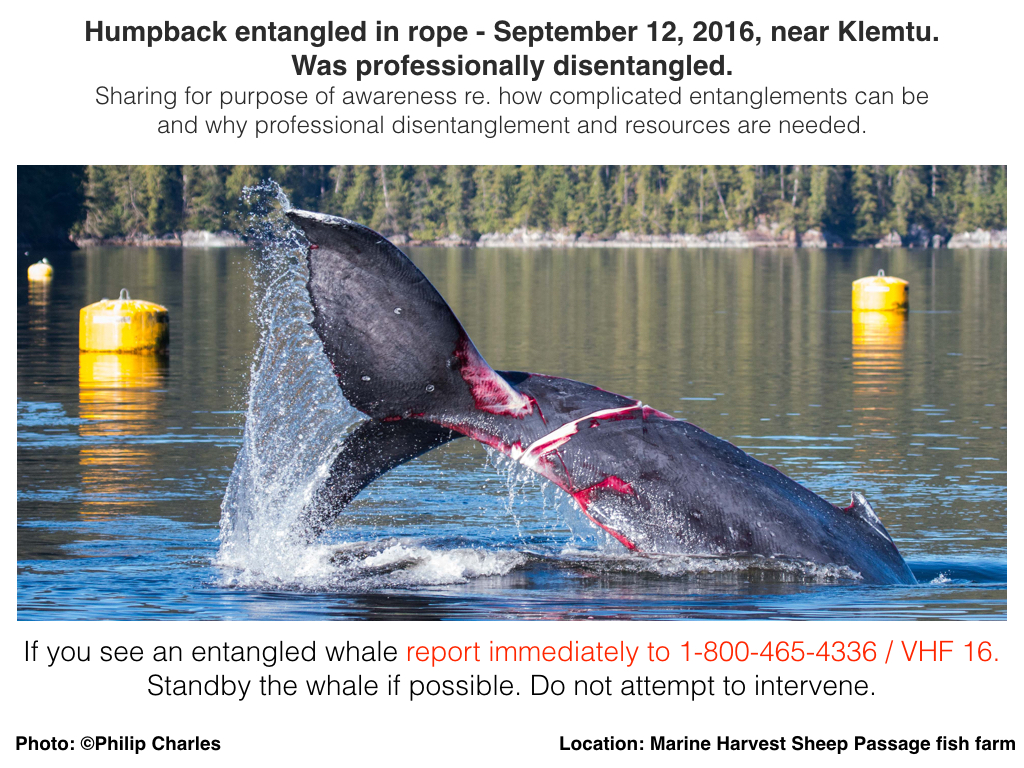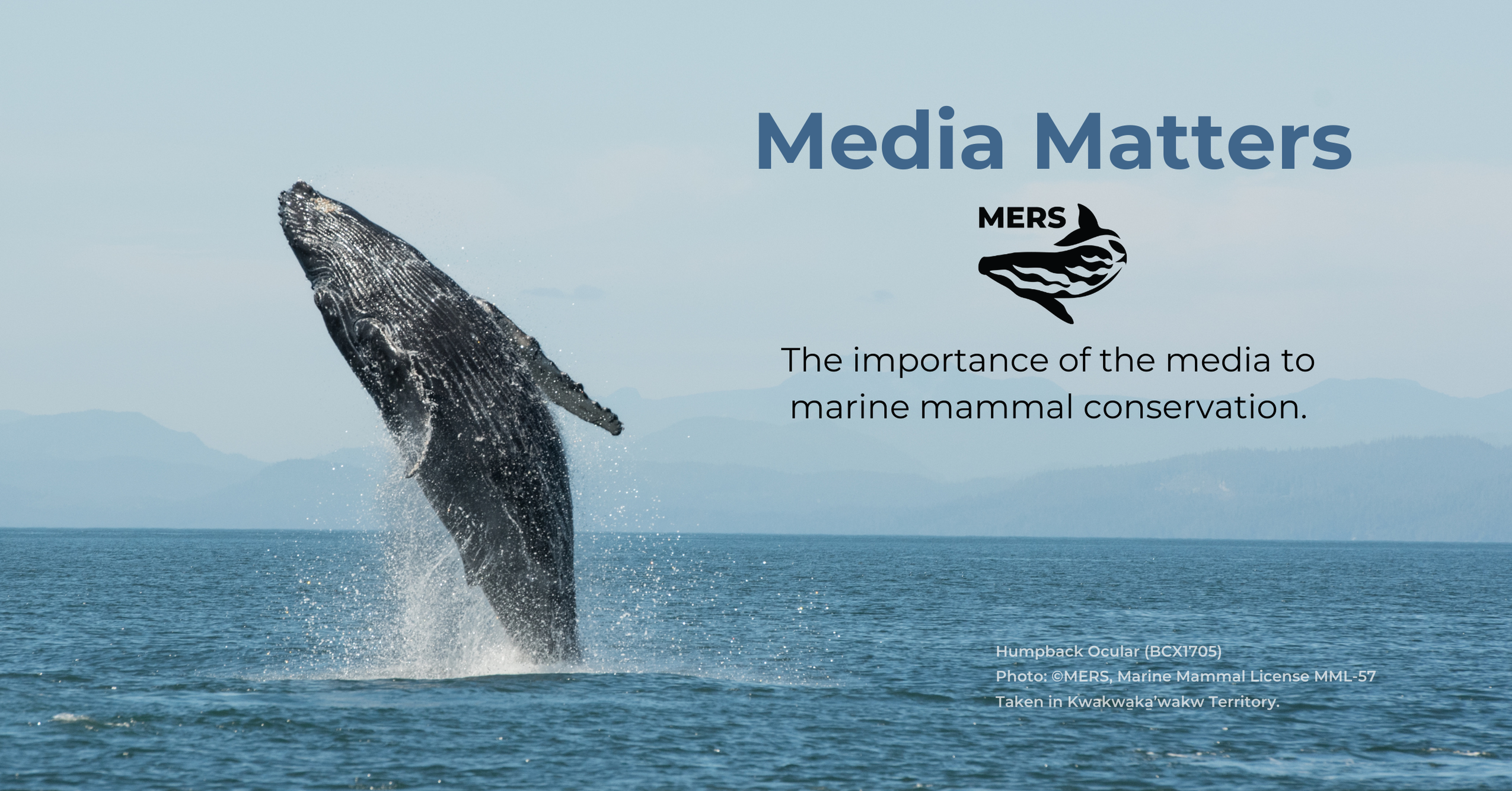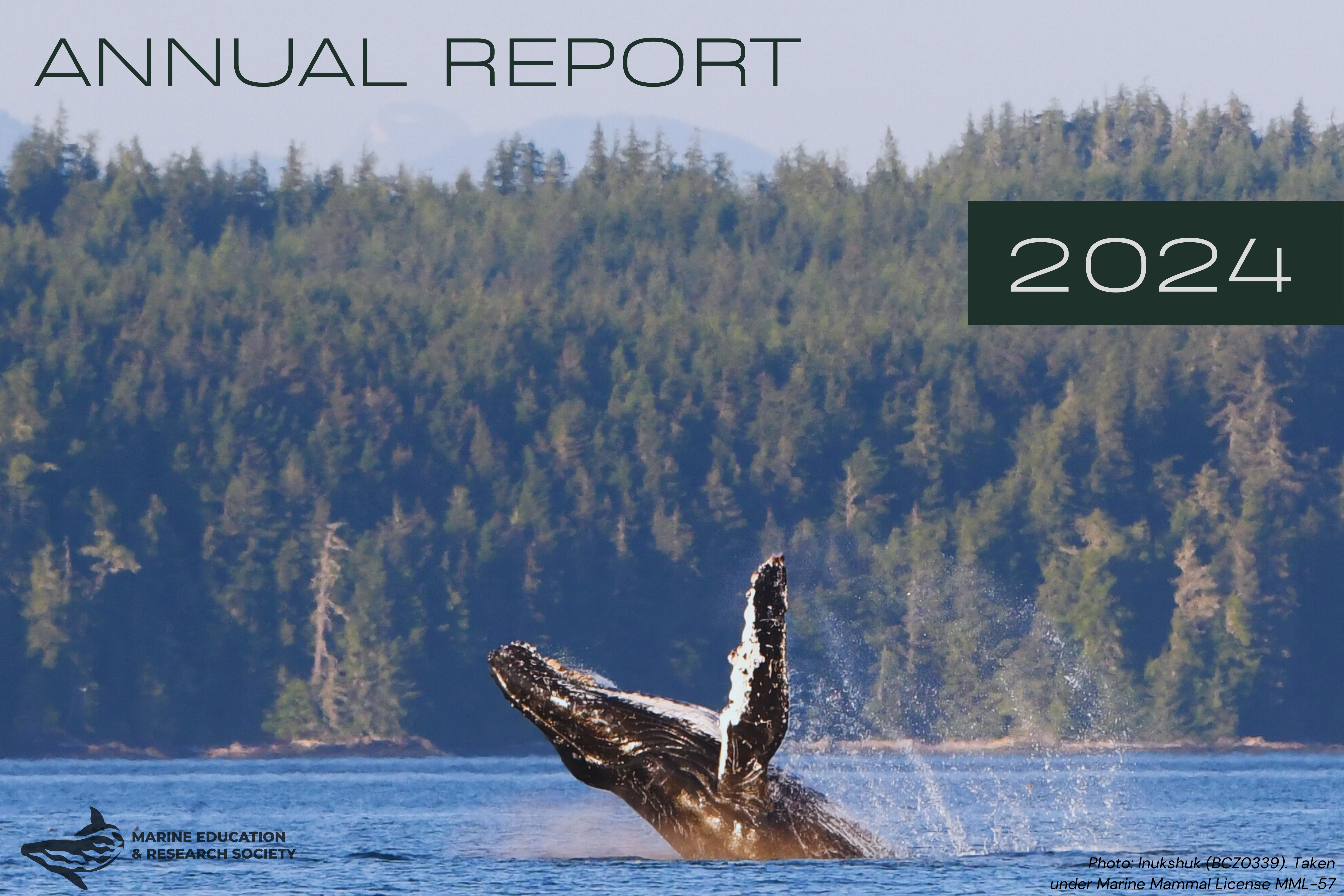Note, this blog was initially written to answer questions about the two Humpbacks entangled at the same site in 2016 – the Sheep Passage open-net farm site near Klemtu. One whale was freed on September 12th (survival unknown) and one died at the same site on November 15th, 2016.
UPDATE December 6, 2018: Humpback found in the Cermaq’s Millar Channel farm. From media provided by Cermaq “The cage was empty and did not contain any salmon and the whale was in good health, not entangled and not exhibiting signs of stress”. Plan for release of the whale was coordinated by DFO. ID of the whale is not known to date and it is unknown how the whale entered the nets.
UPDATE July 2018: Amendments to Canada’s Marine Mammal Regulations came into force on July 11, 2018. The amendments include mandatory reporting of any accidental contact between a marine mammal and a vehicle or fishing gear. Click here for the full Regulations.]
UPDATE January 1, 2017: New Regulation went into effect requiring any fishery/aquaculture exports to the U.S. to meet equivalent standards of the Marine Mammal Protection Act for monitoring and bycatch mitigation. There is a 5-year exemption period (to January 10, 2022).
UPDATE November 29, 2016: Another Humpback Whale has died in open-net fish farm gear. This whale was at the Grieg Seafood’s Atrevida farm in Nootka Sound. This is the 2nd Humpback Whale dead at a fish farm in two weeks and the 3rd that is known to have been entangled in fish farm gear in 2.5 months. See this link for further information.
Updated summary of known Humpback interactions with open net-pen salmon farming netting / cages:
- November 14, 2021 – Cermaq facility Well’s Pass – Humpback entrapped. Conditions of license not followed.
- December 2, 2018 – Cermaq’s Millar Channel farm. Whale reported to be within the farm but not entangled nor injured. Plan for release of the whale was coordinated by DFO. ID of the whale is not known to date and it is unknown how the whale entered the farm.
Related media: Cermaq, December 4, 2018 “Humpback Whale Freed from Empty Salmon Farm Cage without Incident“ - November 29, 2016 – Grieg Seafood’s Atrevida farm in Nootka Sound. Humpback found dead in nets. Necropsy results unknown. ID of dead whale not known.
Related media: CTV News; November 29, 2016; “Dead humpback whale found at B.C. salmon farm“ - November 15, 2016 – Marine Harvest’s fallow Sheep Passage open-net farm site near Klemtu. Humpback found entangled and dead. This is the same site as the entanglement of September 12, 2016. ID of whale not known.
Related media: See end of blog. - September 15, 2016 – Marine Harvest’s fallow Sheep Passage open-net farm site near Klemtu. Humpback found entangled and was professionally disentangled. ID of whale not known. Survival not known.
Media: See end of blog. - March 27, 2013 – Mainstream Canada’s Ross Pass farm. Humpback dead. Necropsy inconclusive if whale was dead before or after becoming entangled in fish farm gear.
Related media: Times Colonist; March 27, 2013, “Dead humpback whale floats up at salmon farm near Tofino“
Initial blog from November 22nd, 2016
As a result of our research to understand and reduce risk of entanglement for Humpbacks and our efforts to increase awareness about what to do if an entanglement is witnessed, we’ve been getting a lot of questions about the latest known Humpback entanglement on BC’s Central Coast. Many of the questions were generated by Marine Harvest’s November 17th, 2016 release “Whale found dead at empty aquaculture site”.
For the sake of efficiency and awareness raising, we’ve strived to answer the questions below and will update this information as we learn more. Our aim is to help ensure that what is learned from entanglements leads to measures that reduce the risk.
Questions:
1. Was the November 15th entanglement at the same site as the September 12th entanglement?
Marine Harvest has reported that both whales were entangled on the same anchor system at the fallow Sheep Passage open-net farm site near Klemtu.
2. Why was the anchor system not removed?
The latest entanglement is under investigation by Fisheries and Ocean’s Canada (DFO). We are striving to find out if the results will be made public and if the results may inform policy and regulations around open-net fish farm anchor systems.
3. Did the whale entangled at this site on September 12th survive?
The Humpback caught up in the same anchor system on September 12th was disentangled by those with training (disentanglement must be coordinated by DFO and done by those with training, see #9 below). This was a very complex entanglement (see photo and video below) but all gear was successfully removed from the whale. It is not possible however to definitively say that the whale survived the injuries as there have been no documented re-sightings.
4. How did the whale found on November 15th die?
Whales are mammals and therefore need to come to the surface to breathe. They will drown if they are anchored to the bottom because of being trapped in ropes or fishing gear. It is hoped that the DFO investigation will provide insight into the specifics of this anchor system and how the Humpback died. Wherever there are lines or fishing gear in the ocean, there is the potential for entanglement, especially in areas where Humpbacks are feeding. They feed on krill and small schooling fish like herring and it can be expected that these prey are in the same areas as open-net fish farms. It is essential to realize that Humpbacks do not have the biosonar that toothed whales like Orca have and they can be extremely oblivious of boats, let alone fishing gear.
Also note that if whales have enough mobility to swim away, entanglement also can also cause death due to the fishing gear in which they are wrapped leading to serious injuries and infections, and/or because the gear makes it impossible for them to travel and feed effectively.
5. How often to whales die from entanglement on BC’s coast?
Preliminary research conducted by the Marine Education and Research Society and DFO supports that 47% of Humpbacks have scarring on their tailstocks that indicate that they have been entangled and survived, i.e. almost one in two Humpbacks that feed on BC’s coast have been entangled at some point in their lives (>1,000 Humpbacks). This indicates how widespread the risk of entanglement is, but does not indicate how many Humpbacks die due to entanglement. Dead whales most often sink to the ocean bottom whereby their deaths cannot be documented. If their bodies do wash ashore on BC’s vast coastline, often they are so decayed that cause of death cannot be determined.
6. Have there only been two Humpback Whales entangled in Marine Harvest open-net salmon farms in the last 30 years?
Yes, specifically at Marine Harvest farms, and specifically for this marine mammal species, there have been two reported cases of Humpback entanglement. There was another documented case of a dead Humpback Whale at an open net fish farm in March 2013 near Tofino at a Mainstream Canada site (now Cermaq). The statement regarding “30 years” in “Whale found dead at empty aquaculture site” must be weighted out against the reality that Humpbacks were extremely rare on BC’s coast even 15 years ago. Humpbacks were whaled in BC waters up to 1966. To give an indication of how Humpback numbers have increased since then, our research shows that in the islands outside Telegraph Cove on NE Vancouver Island alone, we documented just 7 Humpbacks in 2004 and, this year to date, we have documented 83 individuals (some just passing through). The population estimate for Humpbacks feeding in BC waters is at least 2,000 individuals. With more Humpbacks, there is more risk of entanglement.
7. Are there regulations around the gear left at fallow fish farms?
No, there are not. It is hoped this will be an outcome of what is learned from these entanglements. See #10 below for what regulations do pertain to aquaculture and marine mammals.

8. Is the ID of the dead Humpback known?
No, it is not known. It is hoped that as part of the investigation, Humpback researchers like ourselves may be able to be of use in trying to identify who this whale was.
9. What should be done if someone witnesses an entanglement?
• With great urgency, report the entanglement with location to the DFO Incident Line / VHF 16. 1-800-465-4336.
• If at all possible, remain with the whale at a distance until trained help arrives or another boat takes over tracking, otherwise the chances of relocating the whale are greatly diminished
• Take whatever video/photos are possible but maintain a distance that doesn’t stress the whale (at least 100 metres).
• Do NOT attempt to remove any fishing gear or rope from the whale as it risks human and whale safety (has led to human death). Professional training and equipment are needed to assess the entanglement and proceed safely with the greatest chance of success. Often, much of the fishing gear in which the whale is entangled is not visible at the surface. If well-intentioned members of the public remove the gear at the surface, it is made much more difficult to: (1) recognize that the whale is entangled; and (2) disentangle the whale even if it is relocated. Trailing gear at the surface provides the opportunity for trained responders to attach a tag to track the whale and/or to attach floatation to maintain contact with and slow down an entangled whale. Loss of this gear can significantly reduce rescuers’ ability to save the whale.
For more information regarding reducing the risk of vessel strike and entanglement, see www.SeeABlowGoSlow.org.
10. What regulations are there around reporting and reducing the risk of entanglement at finfish aquaculture sites?
• [Update July 2018 – Amendments to Canada’s Marine Mammal Regulations came into effect on July 11th. The amendments include mandatory reporting of any accidental contact between a marine mammal and a vehicle or fishing gear. Click here for the full Regulations.]
• In the Pacific Aquaculture Regulations, marine mammals are regulated under the term “nuisance fish” and there is obligatory reporting on “the number and species of nuisance fish that die as a result of the aquaculture facility’s operations.”
• Section 10 of the Marine Finfish Aquaculture License specifies conditions around “management of Marine Mammal Interactions” and includes “The licence holder must notify the Department [DFO] of any marine mammal drowning mortality or entanglement (live or dead) not later than 24 hours after discovery.”
An important development in the United States is that as of January 1, 2017, foreign fisheries must adhere to the provisions of the Marine Mammal Protection Act (MMPA) which address the incidental mortality and serious injury of marine mammals. There is an exemption period for compliance to January 10, 2022. The provisions include:
- With respect to foreign fisheries, section 101(a)(2) of the MMPA states that the Secretary of the Treasury shall ban the importation of commercial fish or products from fish which have been caught with commercial fishing technology which results in the incidental kill or incidental serious injury of ocean mammals in excess of United States standards. For purposes of applying the preceding sentence, the Secretary of Commerce shall insist on reasonable proof from the government of any nation from which fish or fish products will be exported to the United States of the effects on ocean mammals of the commercial fishing technology in use for such fish or fish products exported from such nation to the United States. (16 U.S.C. 1371(a)(2))
- Section 102 (c)(3) of the MMPA states that it is unlawful to import into the United States any fish, whether fresh, frozen, or otherwise prepared, if such fish was caught in a manner which the Secretary of Commerce (Secretary) has proscribed for persons subject to the jurisdiction of the United States, whether or not any marine mammals were in fact taken incident to the catching of the fish. (16 U.S.C. 1372(c)(3)).
Contact information: For further information regarding the work of MERS to understand the risk of entanglement to Humpbacks: Email info@mersociety.org. Phone 250-956-3525 or 250-230-7136.
Media related to the two November 2016 entanglements referenced above:
- CBC News; November 30, 2016; “2nd humpback death in 2 weeks worries experts, farmed salmon industry“
- North Island Gazette; November 30, 2016; “MERS hoping investigation leads to reduced risk to whales“
- Global News; November 30, 2016; “DFO opens investigation into humpback whale death near Klemtu, B.C.”
- CBC News; November 23, 2016; “Researchers fear B.C. coast becoming dangerous for returning whales – Conservation group says research suggests 47% of humpbacks have scarring indicating entanglements”
- CBC News; November 19, 2016; “Humpback whale found dead near Klemtu, B.C., says aquaculture company”


